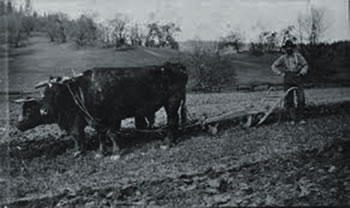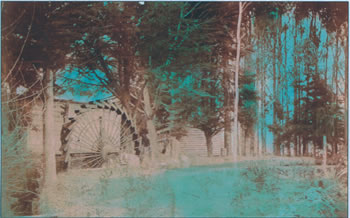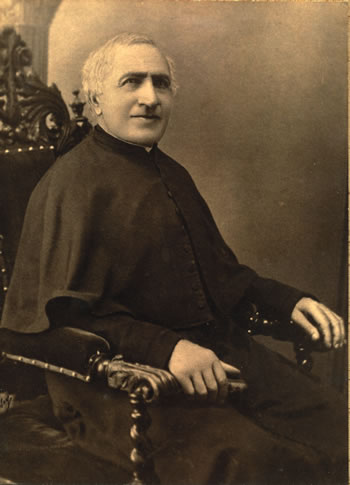Father Jean Baptiste Comte (Pa Kometa) – Pt 1
By Ken Scadden (with editing and French translation assistance of Elizabeth Charlton.)
Father Jean-Baptiste Comte was born in the hamlet of Silcuzin, Siaugues, St-Romain , Haute Loire, France on 25 January 1812. He was ordained a priest 13 March 1838 at Belley by Bishop Devie. He transferred to the Society of Mary on 14 July 1838 and was professed on 19 May 1839.
He arrived in New Zealand in the Martha on 12 December 1839. Initially he was appointed to the Auckland Maori Mission where he learned to speak Te Reo Maori.
In July 1840 he was sent by Bishop Pompallier to extend the Marist Mission to Maori beyond the far north. He embarked along with Father Jean Pezant SM and Brother Florentin SM on the French vessel Aube for Akaroa as part of the Nanto-Bordelaise Company plan to establish a French colony in the South Island. Father Comte was chosen by the Expedition leader Monsieur Lavaud to be the interpreter for the group and together with Father Comte and Brother Florentin their mission was to spread the Gospel to Maori.
Father Comte was particularly useful in negotiations between the settlers of the Nanto-Bordelaise Company and local Maori, helping clear up difficult questions between the French purchasers of land at Akaroa and the native vendors.
When Bishop Pompallier arrived in Akaroa on the Sancta Maria on 2 October 1840 he brought with him Father Jean- Andre Tripe who because of difficulty in learning Maori was to minister to the pakeha settlers of Akaroa while Father Comte was tasked with taking the Christian message to the Maori of Banks Peninsula. Unfortunately, the French settlers of Akaroa had more confidence in Father Comte (who was tasked with ministering to Maori ) than Father Tripe who was their dedicated priest.
The first recorded Catholic mass on land in the South Island was held in Akaroa on Sunday 23 August 1840 with Father Comte and Father Pezant officiating. In the concluding months of 1840, the priests baptised seven children, conducted two marriages and two burials. Among those baptised were two children of Maori women and their European whalemen husbands. Fathers Comte and Pezant went south with Bishop Pompallier on the Sancta Maria to Moeraki and Otakou (Otago) returning to Akaroa in December 1840.
The lack of success in converting the Maori of Akaroa saw Father Comte move to Port Levy to see if he could be more successful there. In the meantime Bishop Pompallier visited Otakou and the Chief Taiaroa was anxious to retain them and Bishop Pompallier promised that Father Comte would soon visit Otakou.
Father Comte reported that the Banks Peninsula Kai Tahu had the same customs and beliefs as the Maori whom he had encountered in the North Island but there were certain differences in pronunciation which he noted in some detail. In later years he regretted not having recorded more of their culture, history and traditions.
Like many Marist priests Father Comte also took an interest in the natural surroundings of the settlement of Akaroa. He described the birdsong of the dawn-chorus as :
“ It is before dawn that the birds provide the most beautiful music. It sounds like a concert of a thousand flutes.”
However though they built the first Catholic Church in Akaroa which was completed in the Winter of 1841, neither Fathers Comte nor Tripe was happy in Akaroa. The relatively small Maori population of Banks Peninsular, the indifference of the French settlers to the work of the missionaries and the sectarian wranglings of the Catholic and Protestant missionaries lead to both priests leaving Akaroa. Father Comte left Akaroa for the Bay of Islands in March 1842 followed closely by Father Tripe in November 1842. Father Comte later returned to Akaroa for visits from August to October 1844 and again in December 1845 and September 1847, each time travelling extensively around Banks Peninsular.
In 1843 Father Comte then served briefly at Maketu, Opotoki and in late 1843 he was transferred to Wellington. In 1844 he became the Founder of the Maori Mission in Otaki. Ironically, the principal iwi at Otaki, the Ngati Toa under their formidable chief Te Rauparaha were the deadly enemies of the Kai Tahu of Akaroa. By October 1845 Father Comte had built a church on the top of Pukekaraka Hill.
Father Comte travelled widely in his new domain, visiting the Manawatu, Wanganui( including brief visits up the Whanganui river), Wairarapa, Wellington and Akaroa. When at home in Otaki he taught an elementary school of about forty pupils with more girls than boys attending.
 Father Comte was an early visionary priest on the Maori Mission. His experiences at Akaroa and Maketu had taught him the importance of Maori creating a viable economic base for themselves if they were to retain their land and prosper in the face of increasing numbers of pakeha arriving in New Zealand. He felt that adopting European agricultural and commercial activity went hand in hand with the introduction of Christianity to Maori. To that end he built a ropewalk using local flax which abounded and which he sent to Wellington for sale. Brother Elie Regis Marin planted grapes for Communion wine on Pukekaraka .
Father Comte was an early visionary priest on the Maori Mission. His experiences at Akaroa and Maketu had taught him the importance of Maori creating a viable economic base for themselves if they were to retain their land and prosper in the face of increasing numbers of pakeha arriving in New Zealand. He felt that adopting European agricultural and commercial activity went hand in hand with the introduction of Christianity to Maori. To that end he built a ropewalk using local flax which abounded and which he sent to Wellington for sale. Brother Elie Regis Marin planted grapes for Communion wine on Pukekaraka .
Father Comte encouraged the locals to grow wheat and built a flour-mill (assisted by Brother Elie Regis Marin) using a waterwheel located in the Waitohi stream to drive it and a dam for the dry season 100 yards above the mill. Wheat grown from Paekakariki in the South to the Manawatu in the North was brought to Pukekaraka for grinding into flour. One of Father Comte’s first converts was Hakaria Rangikura , a powerful man who could carry two bags of wheat under each arm. Supported by Father Comte the local Maori grew potatoes which they were able to export to Wellington and sell. They also had crops of oats, maize, barley, kumara, peaches, apples and watermelons .
He also established a timber mill and timber sawn to build a church was ready by 1853. The first church was burnt down in 1856 and although its replacement was begun in 1858 it was not finished for nearly thirty years after Father Comte’s departure.
Father Comte’s endeavours had an enormous impact on local transport and technology. He purchased drays and bullock teams (with four oxen and two ploughs), the first to be seen in the district. In order to get the fruits of the labours of Otaki Maori to Wellington and Porirua he purchased an 8 ton fore and aft schooner the Elizabeth. The produce from the ropewalk would have found a ready market for locally made flax whaling lines, rigging ropes and anchor cables among the whalers at Kapiti Island and around Porirua Harbour.
This vessel was usually skippered by the pakeha skipper, Captain Warren but for several voyages to and from Wellington in the early 1850’s she was skippered by a Maori skipper named Terawatu. Her cargoes into Wellington consisted mainly of rope and potatoes and on the return trips she carried goods such as tobacco, sugar, wine, tea, raisins, salt, blankets sacks, nails, glass, spades, reap hooks , brooms, candles, soap and clothing. These items imported in bulk from Wellington were held in a store run by Father Comte and sold cheaply to local Maori. Eventually Father Comte felt that his being treasurer of the community funds was in compatible with his vow of poverty as a Marist and there was also pressure from his family back in France for him to return and he also had some ill health and so he applied to Bishop Viard for a dispensation from his vows, which was granted.

The flour mill at Pukekaraka. This became inoperable after the 1855 earthquake, as the flow of water from the Waitohu was not enough to turn the wheel. Flour sales had been part of the flourishing trade of the Mission Station.
(to be continued in July Issue)


 Entries(RSS)
Entries(RSS)